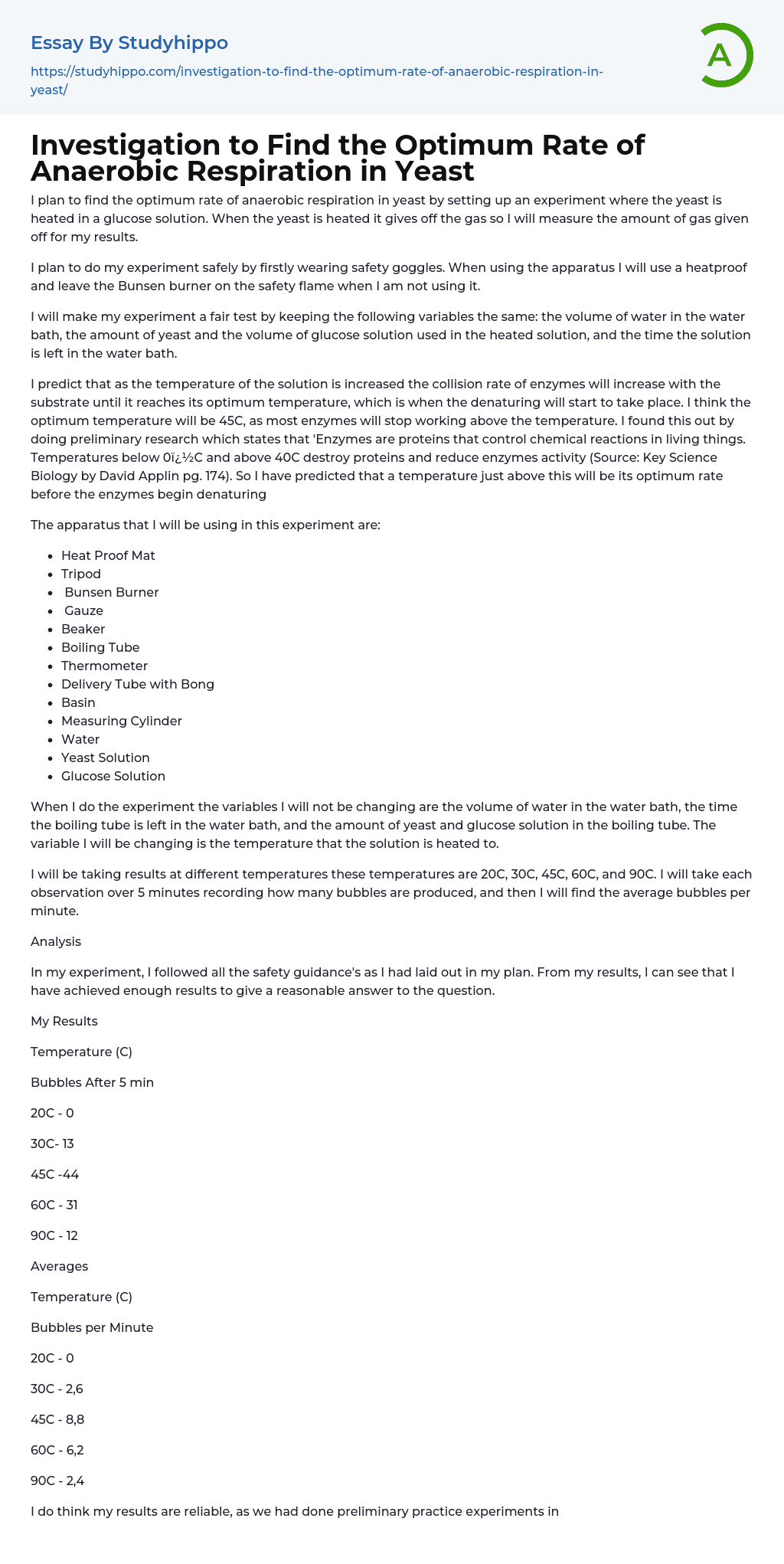

Investigation to Find the Optimum Rate of Anaerobic Respiration in Yeast Essay Example
I intend to determine the optimal rate of anaerobic respiration in yeast through an experiment involving heating the yeast within a glucose solution. The heating process triggers the release of gas, which I will measure as my experimental data. To ensure safety, I will wear protective goggles throughout the experiment. Additionally, I will utilize a heat-resistant apparatus and keep the Bunsen burner on the safety flame when not in use.
In order to ensure a fair test in my experiment, I will keep certain variables constant. These variables include the volume of water in the water bath, the amount of yeast, the volume of glucose solution used in the heated solution, and the duration of time that the solution remains in the water bath. Based on my prediction, I expect that as the temperature of the solution increases, there will be an increase in collision rate between enzymes and s
...ubstrate until it reaches its optimal temperature. After this point, enzymes will begin to denature. I anticipate this optimal temperature to be 45C because most enzymes lose efficiency above this temperature. This conclusion is supported by preliminary research which states that "Enzymes are proteins that regulate chemical reactions in living organisms. Proteins are destroyed and enzyme activity reduces when temperatures fall below 0i??C or rise above 40C" (Source: Key Science Biology by David Applin pg.174).
Based on my prediction, the temperature slightly above this point is where the optimum rate can be maintained before enzyme denaturation occurs. To conduct this experiment, I will utilize various equipment including a heat-proof mat, tripod, Bunsen burner, gauze, beaker, boiling tube, thermometer, delivery tube with bong, and basin.
-
The following equipmen
will be used during the experiment:
<
In analyzing my experiment results,I have strictly adhered to all safety guidelines as planned.
Furthermore, I have calculated the averages for each temperature (C) and the corresponding bubbles per minute as follows:
- 20C - 0
- 30C - 2.6
- 45C - 8.8
- 60C - 6.2
- 90C - 2.4
Based on the aforementioned results, I have confidence in their reliability since we conducted preliminary experiments to rectify any errors that occurred. If given the opportunity to repeat the experiment, I would slightly adjust the range of results. Initially, I would conduct a broader range of temperatures,
followed by a narrower range around the temperature that appears to be optimal. However, despite this potential modification, I believe that my current results are sufficient to draw a valid conclusion.
Conclusion
In light of my findings, I have concluded that the optimal temperature for anaerobic respiration in yeast is approximately 45C. The graph clearly demonstrates that denaturation initiates around 45C, leading to a decline in yeast respiration until it ultimately ceases altogether. My initial prediction was accurate; however, if I had conducted recordings within a narrower temperature range of 40C-50C, there might have been a slight deviation. It would have been more precise to specify a range of temperatures instead of a single temperature. Although my recording at the highest temperature supports my prediction, measuring within a smaller range near that temperature could have resulted in a minor discrepancy of few degrees.
Evaluation
In general, I consider my experiment to be successful despite some minor adjustments that could have been made to enhance accuracy. Although my results were satisfactory, they may not have been optimal. The initial measurements taken at 20C had room for improvement, but it is natural for first attempts to encounter obstacles. Overall, our results are reasonably reliable as they follow the expected trend and we did not obtain any unusual findings. However, the first set was slightly abnormal with no bubbles generated due to an awkward angle of the delivery tube hindering gas escape.
If I were to redo the experiment, there are a couple of modifications I would implement. Initially, I would guarantee that the equipment is arranged with utmost accuracy to attain the most precise outcomes. Additionally, I would perform tests across both
a broad and narrow scope of temperatures in order to establish the optimal temperature more precisely. Besides these alterations, I was generally content with all other aspects of the experiment.
- Bottled Water essays
- Bacteria essays
- Biotechnology essays
- Breeding essays
- Cell essays
- Cell Membrane essays
- Cystic Fibrosis essays
- Enzyme essays
- Human essays
- Microbiology essays
- Natural Selection essays
- Photosynthesis essays
- Plant essays
- Protein essays
- Stem Cell essays
- Viruses essays
- Experiment essays
- Explorer essays
- Hypothesis essays
- Observation essays
- Qualitative Research essays
- Research Methods essays
- Theory essays
- Respiration essays
- Atmosphere essays
- Biodiversity essays
- Coral Reef essays
- Desert essays
- Earth essays
- Ecosystem essays
- Forest essays
- Lake essays
- Natural Environment essays
- Ocean essays
- Oxygen essays
- Rainbow essays
- Sea essays
- Soil essays
- Volcano essays
- Water essays
- Wind essays



